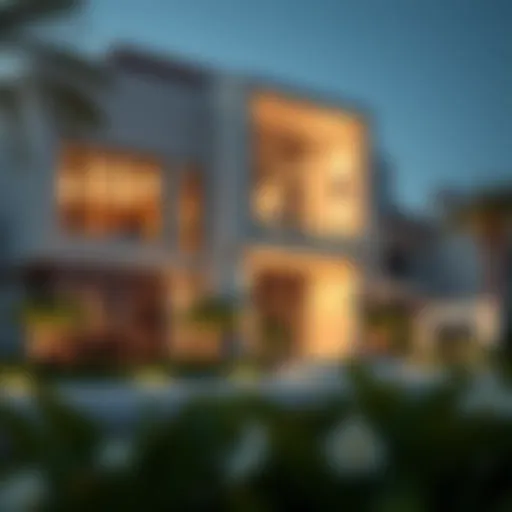UAE Mega Projects: Shaping the Future of Development
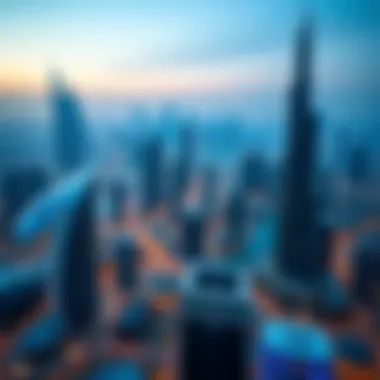
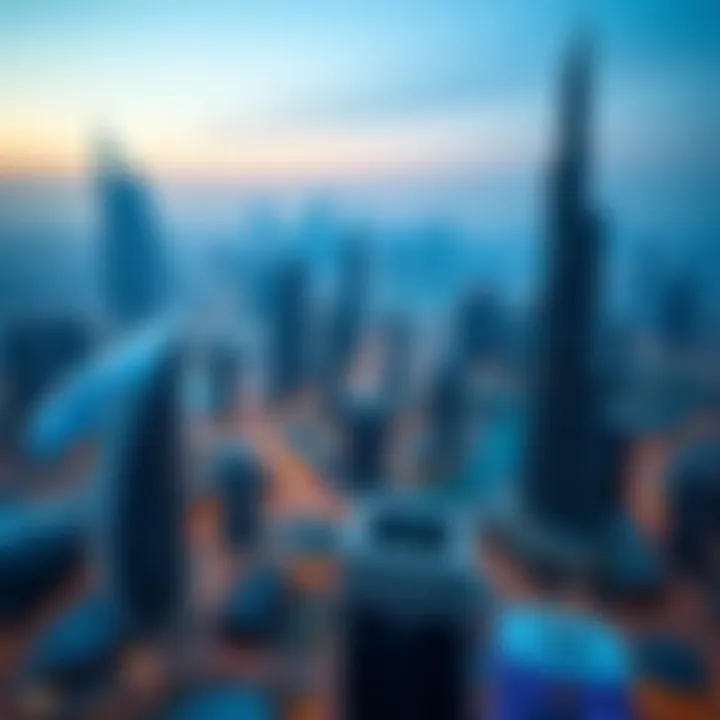
Intro
As the world’s eye turns towards the Middle East, the United Arab Emirates continues to capture attention with its unyielding drive toward innovation and development. This article dives into the mega projects that are not just reshaping skylines but are fundamentally transforming societal and economic landscapes within the UAE. With an ambitious vision, these projects stand as testimony to the region's aspirations, bringing together state-of-the-art design, cutting-edge technology, and a grand scale of execution.
The significance of these projects cannot be overstated. They serve as strategic points of interest for investors seeking lucrative opportunities, while simultaneously providing a flourishing environment for residents and tourists alike. From Dubai’s iconic Burj Khalifa to the ambitious plans for futuristic urban centers, each development tells a unique story of vision, perseverance, and transformation.
Understanding the underlying trends and challenges that accompany such vast undertakings is essential. This is particularly true for real estate stakeholders who are keen on navigating this dynamic landscape. With that in mind, this article will delve deeply into the current property market trends, present key neighborhood insights, and outline essential guidelines for both buyers and sellers in this burgeoning realm.
As the UAE continually strives to position itself as a global leader in various sectors, its mega projects create ripples of change that touch every corner of society. Let's explore the current state of the real estate market, uncover investment opportunities, and look at the implications of these monumental endeavors.
Prolusion to UAE Mega Projects
The concept of mega projects in the UAE has captured the imagination of investors, developers, and general audiences alike. As the nation rapidly evolves, these monumental undertakings serve as a reflection of its ambition and drive towards modernization. This introduction sets the stage for understanding why UAE mega projects are not just mere constructions but are pivotal in shaping the region's social, economic, and cultural landscape.
Definition and Scope
Mega projects refer to large-scale infrastructure initiatives that typically involve significant capital investment and span multiple years for completion. In the UAE, these projects cover a wide range of domains, including real estate, tourism, and transportation. They are characterized by substantial economic implications, often resulting in job creation, enhanced global competitiveness, and a shift in the socio-economic balance of the region. Thus, the scope of mega projects in the UAE extends beyond mere construction; it fosters an environment for innovation, sustainability, and growth.
The allure of mega projects lies not just in their physical structures but in their potential for wider impact. For instance, projects like The Palm Jumeirah and Dubai Creek Tower epitomize the integration of design and functionality, driven by the aspiration to draw tourists and investors alike.
Historical Background
To fully appreciate the current wave of mega projects in the UAE, one must consider the historical context that paved the way for such developments. Following the discovery of oil in the 1950s, the UAE underwent a remarkable transformation. What was once a region characterized by small fishing villages and arid landscapes has evolved into a global hub for commerce and tourism.
The early initiatives focused on basic infrastructure—roads, schools, and hospitals—laying the groundwork for future expansions. The construction of landmarks like Burj Al Arab in the 1990s marked a significant turning point, showcasing the nation’s aspirations on an international stage. The UAE began adopting bold urban planning strategies and attracting foreign investment, positioning itself as a player in the global economy.
With significant projects like the Atlantis Resort and the development of Dubai Marina, the nation's approach to mega projects matured. They began to embody not just luxury and opulence but innovation and sustainability, reflecting a growing awareness of the importance of environmentally-friendly practices. This evolution in thought laid the foundation for the transformative work undertaken today.
Strategic Importance of Mega Projects
The mega projects in the UAE are not just impressive feats of engineering; they hold a pivotal place in the country’s quest for economic growth and stability. These grand developments are primarily crafted to serve dual purposes: enhancing the country's global image while also addressing critical economic goals. The significance of these projects is underscored by their role in reshaping markets, elevating living standards, and attracting investments from all corners of the globe.
Economic Diversification Goals
Having long depended on oil revenues, the UAE has recognized the need to diversify its economy. Mega projects serve as a catalyst in this transition. They create jobs, stimulate various sectors, and help decrease reliance on oil by emphasizing tourism and real estate. For instance, developments like Abu Dhabi’s Saadiyat Island and the Louvre Abu Dhabi aim to establish the emirate as a cultural hub. This diversification fosters a more resilient economy that can weather fluctuating oil prices.
Several initiatives tackle specific economic sectors:
- Tourism: Projects like the Bluewaters Island and the upcoming developments around Expo 2020 are designed to attract millions, drawing visitors and their spending power.
- Transport and Logistics: The expansion of Dubai’s logistics capacity through projects like the Dubai Multi Commodities Centre is pivotal in not just improving trade facilities but also in establishing the UAE as a key player in international trade.
Moreover, as these mega projects emerge, they often lead to the development of smaller businesses and services, providing a holistic boost to the economy. The ripple effect touches areas ranging from construction to retail, creating diverse job opportunities.”
Global Competitiveness
In an increasingly competitive global landscape, the UAE is leveraging mega projects to position itself as a leader. While the rapid growth in infrastructure and services is impressive, it's the strategic importance of these projects that truly sets the emirate apart. For example, the Burj Khalifa is not only a landmark but also a symbol of the country’s innovative spirit.
Investment in state-of-the-art facilities and attractions enhances the UAE’s overall competitiveness. The mega projects ensure that the country is not just participating in, but excels within the global arena. Key elements include:
- Enhanced Infrastructure: Facilities such as the Dubai Metro and the expansion of the Abu Dhabi International Airport facilitate better connectivity, critical for international business.
- Attracting Foreign Investment: With sophisticated infrastructure, the UAE becomes a magnet for international investors seeking stable and lucrative opportunities. Projects designed with foreign investors in mind are crucial, as they illustrate the potential for profitable returns.
"Mega projects serve not just as development landmarks but as key drivers of future economic stability and growth in the UAE."
These developments showcase innovative architecture and technology, encouraging businesses worldwide to establish their presence in the UAE. The continued emphasis on mega projects supports the ongoing transformation of the UAE into a hub for innovation and business, ensuring its competitive edge in the long term.
Notable Mega Projects in the UAE
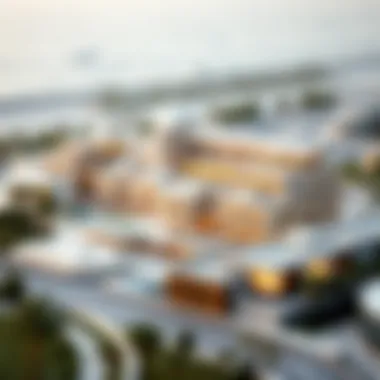
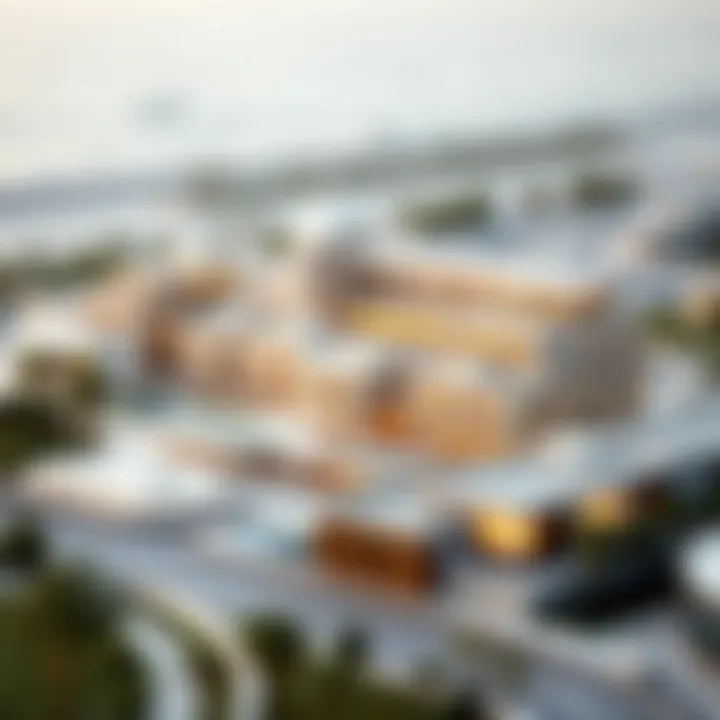
The United Arab Emirates has carved out a niche in the global construction landscape, largely due to its monumental mega projects that not only symbolize its ambition but also serve as catalysts for economic growth and tourism. These projects collectively reflect the UAE's vision of a diverse and competitive economy while also redefining urban living. In this section, we will explore some of the most notable mega projects in the UAE that stand as testaments to innovation, resilience, and strategic planning.
Dubai Creek Tower
The Dubai Creek Tower, anticipated to be one of the tallest structures in the world, is poised to become an iconic landmark in Dubai's skyline. Designed by the renowned Spanish architect Santiago Calatrava, the tower draws inspiration from the shape of a lily, an emblem of beauty and resilience. This awe-inspiring structure aims to soar over 1,000 meters, eclipsing even the Burj Khalifa, which has long held the title of the tallest building.
The significance of Dubai Creek Tower is multifaceted. For investors, it represents a unique opportunity in real estate development, as the surrounding area, known as Dubai Creek Harbour, is being developed into a vibrant mixed-use community. Retail outlets, residential spaces, and recreational amenities will transform the region into a bustling hub for both locals and tourists. Moreover, the tower is expected to attract a considerable number of visitors, enhancing Dubai's status as a leading global destination.
Mohammed Bin Rashid City
Mohammed Bin Rashid City is envisioned as a dynamic community that harmoniously blends residential, commercial, and leisure spaces. Spanning over 45 million square feet, this mega project aims to house over one million residents. The city will feature numerous parks, water channels, and cultural attractions, including the expansive Dubai Hills Park and a cultural district dedicated to art and innovation.
What truly sets Mohammed Bin Rashid City apart is its unique integration of various aspects of modern urban living. Investors are presented with lucrative opportunities as the project encompasses high-end residential developments, hotels, and retail centers, all designed with sustainability and livability in mind. Additionally, the positioning of this mega project within close proximity to key transport links and other urban centers enhances its appeal.
The Palm Jumeirah
Often dubbed as the eighth wonder of the world, The Palm Jumeirah continues to be a hallmark of Dubai’s extravagant lifestyle. This man-made island, resembling a palm tree, extends into the Arabian Gulf and boasts luxurious resorts, upscale villas, and awe-inspiring beachfront properties. Not just a residential haven, it is also home to attractions such as the renowned Atlantis, The Palm resort, which offers thrilling water parks and aquarium experiences.
The significance of The Palm Jumeirah lies beyond its aesthetic appeal. It has become a beacon for luxury tourism, drawing visitors from across the globe. For real estate investors, the opportunities here are immense. Properties on the Palm command high rental yields and have constantly appreciated in value. As demand for exclusive beachfront living continues to rise, The Palm Jumeirah remains a coveted spot for affluent buyers and investors alike.
Expo Dubai
Originally scheduled for 2020, the rescheduled Expo 2020 Dubai began its run in October 2021 and is a groundbreaking event showcasing innovation, culture, and collaboration among nations. Hosting over 190 countries, the World Expo is expected to attract millions of visitors, showcasing cutting-edge technologies and pioneering ideas in sustainability, mobility, and opportunity.
The impact of Expo 2020 on the UAE’s economy cannot be overstated. It is expected to generate significant revenue not only from tourism but also from investments in infrastructure and technology sectors. For investors, the event serves as a launching pad for numerous business opportunities, particularly in the hospitality and service industries. The legacy left by this mega event will undoubtedly influence the region’s development trajectory in the years to come.
The future is bright for the UAE as it continues to push boundaries and redefine what is possible in urban development. These mega projects represent not just buildings, but dreams made tangible.
Investment Opportunities in Mega Projects
Investment opportunities in mega projects represent a significant aspect of the UAE's current and future economic landscape. These projects not only reshape urban areas but also provide a rich ground for investors looking for lucrative avenues. As the nation aims for diversified growth, understanding the investment possibilities within these grand designs is crucial for stakeholders, including developers, investors, and the general public keen on tapping into real estate markets.
The growth of mega projects in the UAE creates direct pathways for long-term investments that are expected to yield impressive returns. The strategic focus on infrastructure is particularly beneficial, as it promises stable income streams and capital appreciation over time.
Furthermore, the allure of these projects often lies in their innovative approach to urban planning, sustainability, and technological advancements. Investors are looking to dive into developments that not only generate profit but also contribute to the community and the environment.
Real Estate Development Potential
In the heart of these mega projects is real estate development potential that has turned the UAE into a real estate haven in the Middle East. Mega developments like Mohammed Bin Rashid City showcase vast land parcels that promise high returns due to their strategic locations, modern amenities, and rich lifestyles offered to potential residents.
- Diverse Property Options: From luxury villas to commercial spaces, these projects contain a variety of property types, catering to different investor interests. Whether targeting high-end clients or aiming for affordable housing, there’s something for everyone.
- Increased Demand: The ever-growing population looks for quality living standards. UAE’s mega projects are on their heels; they’re tapping into that demand, providing modern facilities and enhanced infrastructure which in return boosts property values.
Investors can capitalize on this momentum, as ongoing developments continually attract interest from local and foreign buyers alike, making UAE’s real estate sector dynamic and highly appealing. Unsurprisingly, many are keen to get a foot in the door.
Tourism and Hospitality Ventures
Tournament of global investments aside, tourism and hospitality sectors within mega projects are equally telling. With Dubai wrapped around the idea of being a world-class leisure destination, projects like Expo 2020 Dubai focus on creating spaces that foster tourism while driving significant revenue.
- Luxury Accommodations: Developments often include hotels, resorts, and entertainment complexes, providing diverse options for tourists.
- Cultural Experiences: The integration of culturally rich locales within mega projects enhances the travel experience, attracting tourists who seek authentic experiences alongside luxurious stays.
Investors eyeing the hospitality sector within these projects stand to gain, as the UAE continues to push its agenda as a tourist hotspot. Additionally, with events like the Expo drawing in millions, the ripple effects are immense, benefitting local businesses and the overall economy. This aspect cannot be downplayed.
Infrastructure and Utility Improvements
Oz the closing strands of transformation come into sight, infrastructure and utility improvements become prominent players, knitting the very fabric of urban living. The UAE has been relentless in modernizing its infrastructure to support mega projects, balancing growth with sustainability.
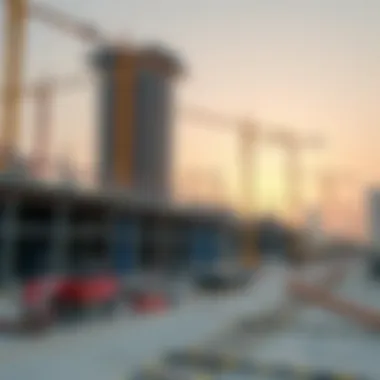
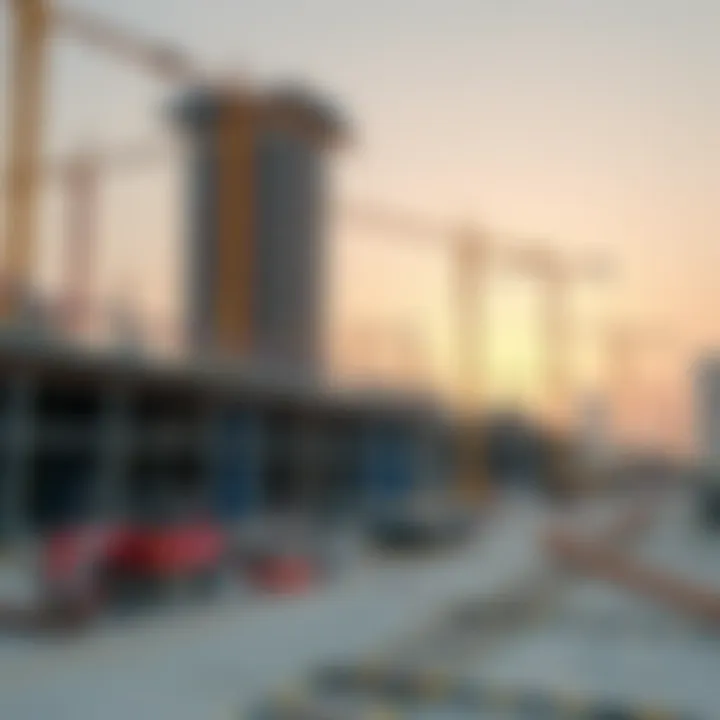
- Smart Infrastructure: Initiatives such as smart grids and sustainable transport systems are increasingly intertwined into the fabric of mega developments, significantly boosting their appeal and functionality.
- Utility Accessibility: Enhanced supply chains for essential services like water, waste management, and energy align with the needs of communities, making living in these developments a sought-after experience.
Investors in this realm should note the increasing importance of infrastructure as a vehicle for development, as sound utility provisions directly correlate with property desirability and overall market resilience.
"Investment in mega projects is not just about bricks and mortar; it is about contributing to a vision that elevates the standard of living in the region."
Challenges Faced by Mega Projects
In any ambitious development endeavor, challenges are par for the course. Mega projects in the UAE are no exception. Understanding these challenges is crucial for investors, stakeholders, and professionals within the industry. Not only can these hurdles stall progress, but they can also impact the overall feasibility and sustainability of the projects. Ignoring these elements may lead to underestimated risks and financial shortfalls, which can have a cascading effect on stakeholders involved.
Economic Volatility
Economic fluctuations pose a significant threat to mega projects, especially in regions heavily reliant on oil revenues like the UAE. Price drops in oil can impact funding availability, thus directly affecting ongoing or prospective projects. For instance, if oil prices go south, there might be fewer funds flowing into development, resulting in project delays or even cancellations. Investors must tread carefully in this climate, keeping an eye on global economic indicators and employing robust risk management strategies.
"In the vast world of investments, understanding economic tides can mean the difference between success and failure."
Adjusting to these economic shifts requires flexibility. Stakeholders must adopt agile procurement and staffing methods to avoid being caught flat-footed. Moreover, during economically turbulent times, public sentiment can turn unfavorable, putting additional pressure on capital investments.
Environmental Concerns
The UAE, known for its ambitious architectural feats, faces increasing scrutiny regarding the environmental ramifications of its mega projects. Urban expansion and infrastructure developments often lead to habitat destruction and increased carbon footprints. Prolonged construction activities can harm local ecosystems, while higher energy demands from mega projects contribute to environmental degradation. These concerns cannot be overlooked as global awareness of climate issues continues to rise.
Investments in sustainable technologies and eco-friendly practices are now essentials rather than luxuries. Developers are compelled to find a balance between progress and ecological considerations. For instance, using renewable energy sources, water recycling systems, and green building materials not only mitigates environmental impact but also enhances public perception, which is invaluable in today’s market.
Regulatory Framework Issues
Navigating the regulatory landscape surrounding mega projects in the UAE can be quite a labyrinth. Although the government supports development, various regulations exist to ensure that projects align with national interests, safety standards, and environmental laws. This regulatory scrutiny can lead to delays, added costs, and complications during the approval process.
It’s beneficial for developers to have local legal experts who can help them untangle the complex web of regulations. Understanding these legal frameworks can accelerate project timelines by ensuring compliance from the outset. Knowing the ins and outs of local laws can make the difference between smooth sailing and a tangle of bureaucratic red tape.
In summary, those looking at mega projects in the UAE must remain vigilant in the face of economic fluctuations, environmental implications, and regulatory issues. Planning with these challenges in mind not only prepares stakeholders for potential pitfalls but also offers an opportunity to innovate and adapt, securing both the project's success and the future sustainability of the UAE's development landscape.
The Role of Technology in Mega Projects
The integration of technology in mega projects within the UAE has become a cornerstone of contemporary development strategies. In a nation known for its ambitious architectural feats and rapid urbanization, the adoption of cutting-edge technologies not only expedites the construction processes but also enhances overall project quality. Recognizing that technology streamlines operations, minimizes errors, and optimizes resources is essential for investors looking to navigate this dynamic landscape.
Innovations in Construction
One cannot overlook the profound impact of innovations in construction on mega projects. For instance, Building Information Modeling (BIM) allows architects and engineers to collaborate in real time, creating a digital twin of a structure before a single brick is laid. This practice not only reduces the likelihood of costly mistakes but also saves time.
Drones too have made quite the splash, providing aerial surveys and aiding in real-time project monitoring. By capturing precise data, stakeholders can make informed decisions, significantly reducing delays. Moreover, additive manufacturing, often referred to as 3D printing, is starting to reshape traditional construction methods. The recent construction of a 3D-printed villa in Dubai is a testament to how these technologies can turn dreams into reality.
Smart City Developments
Smart city technology plays an indispensable role in shaping the cities of tomorrow, especially in the UAE. With projects like Masdar City showcasing renewable energy and sustainable urban living, the adoption of the Internet of Things (IoT) has paved the way for interconnected living environments. Infrastructure such as smart traffic management systems and waste management solutions reduce resource consumption and promote efficiency.
Furthermore, developments like the Dubai Smart City initiative emphasize integrated solutions for everything from energy to public safety. Using big data analytics not only enhances city planning but also improves the quality of life for residents. Cities aren't just becoming more efficient; they are evolving into cohesive spaces that respond to the needs of their inhabitants in real-time.
Sustainability Practices
The emphasis on sustainability practices cannot be overstated in the context of mega projects. Engineers and developers now face the challenge of blending innovation with eco-friendliness. Implementing energy-efficient technologies, such as solar panels, water recycling systems, and green materials, is not merely a trend but a necessity in today's construction landscape.
For example, the construction of the Dubai Frame focused on utilizing sustainable practices by incorporating green roofs and energy-efficient building systems. This approach doesn't just reduce the carbon footprint; it also resonates with a global audience increasingly invested in environmental responsibility. Organizations are increasingly prioritizing sustainability, as investors are keen on aligning their portfolios with eco-conscious initiatives.
"Innovative technologies enable us to construct not just buildings, but sustainable ecosystems that prioritize the well-being of their communities."
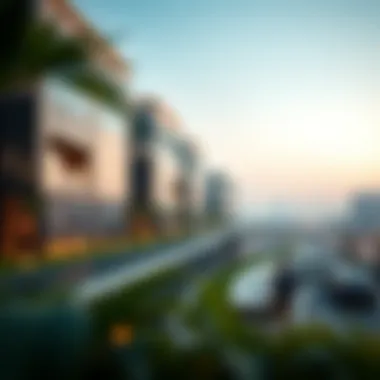
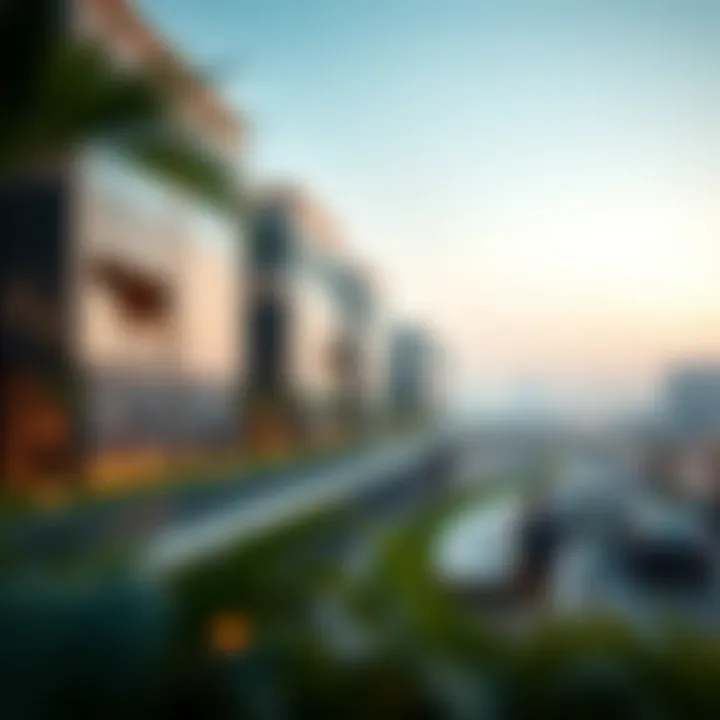
Socio-Cultural Impact of Mega Projects
The socio-cultural ramifications of mega projects within the UAE context cannot be overstated. These projects do not solely redefine the physical landscape; they remake the very fabric of society by addressing community needs and enhancing cultural identity. The dynamics between development and societal evolution emerge as a crucial discourse, encompassing new opportunities, collaborative initiatives, and preservation of heritage.
Community Development Initiatives
Mega projects in the UAE have spearheaded significant community development initiatives. The government understands that while towering skyscrapers and luxurious resorts attract global attention, true development lies in uplifting communities. For instance, the Mohammed Bin Rashid Housing Establishment works hand in hand with the Emirates to provide affordable housing for locals. This initiative fosters a sense of belonging and stability, drawing local families into the fold of urban advancements.
Moreover, projects like the Al Wasl Plaza at Expo 2020 are designed as hubs for community gatherings, showcasing not just architectural brilliance but an intertwining of social cultures. These developments promote diverse engagements through cultural festivals, workshops, and social events, hence fortifying community ties. This holistic approach ensures that while mega projects transform the skyline, they also stitch a vibrant community fabric through shared experiences.
Cultural Integration and Preservation
With the rapid pace of development, addressing cultural integration needs becomes paramount. UAE mega projects are not just about modernity; they also aim to showcase the rich tapestry of heritage. The Louvre Abu Dhabi is a sterling example—a magnificent architectural marvel that houses art and artifacts from diverse cultures around the globe. Nevertheless, it also preserves Emirati culture by presenting it on a world stage, creating a dialogue between tradition and contemporary artistic expressions.
Furthermore, the preservation of historical sites amid urban expanse illustrates the balancing act that developers and planners must perform. Projects such as the restoration of Al Fahidi Historical Neighborhood depict a commitment to preserving Emirati heritage. Maintaining these cultural touchstones provides a grounding sense of identity for residents and visitors alike, fostering respect and understanding among the various communities living in the UAE.
"Cultural integration via mega projects ensures that modernity does not erase tradition, but instead enriches it like colors on a vibrant canvas."
Investors and developers must continually recognize the significance of embedding cultural themes into their projects. Engaging local communities, embracing cultural practices, and respecting historical narratives are not just benevolent gestures; they are essential for sustainable growth and longevity in the UAE's flourishing socio-economic landscape. In essence, understanding the socio-cultural impact paves the way for devising mega projects that empower communities while resonating with their identity.
Future Trends in UAE Mega Projects
The UAE has constantly set itself on a path of breakneck growth and development, and its mega projects are emblematic of this ambition. As the nation eyes the future, it’s becoming ever clearer that trends in technology and market shifts will play pivotal roles in shaping upcoming projects. Now, let’s dive into a couple of important trends that are bound to influence the landscape of UAE’s development.
Emerging Technologies
With innovation coursing through the very veins of the UAE’s mega projects, emerging technologies are set to transform not just construction methodologies but the way entire cities operate. The integration of Artificial Intelligence and Machine Learning into planning and construction processes can reduce costs and enhance efficiency. Consider a smart construction project utilizing drones to survey land or robots to conduct repetitive tasks. These applications don’t just save time; they also minimize human error, pushing projects toward completion faster than ever.
Energy solutions are also taking center stage. Advances in solar power technology mean mega projects can harness the sun's energy more efficiently, aligning with global sustainability goals. This is quite important given that the UAE aims to become a leader in renewable energy. Imagine the sprawling structures of tomorrow—powered primarily by solar energy, reducing dependence on non-renewable sources. It’s key to attract investors who are now more environmentally conscious.
Furthermore, the Internet of Things (IoT) allows for smarter buildings and infrastructure. Sensors that monitor everything from air quality to structural integrity open new doors for enhanced living conditions. As these technologies continue to evolve, they may well define the UAE’s urban future—creating environments that not only look stunning but are inherently more livable and functional.
Evolving Market Dynamics
The market dynamics surrounding mega projects in the UAE are always shifting. Investors are not just looking for lucrative opportunities; they also want reassurance of sustainability and resilience in uncertain times. As the country’s economy diversifies away from oil reliance, there is growing confidence in sectors like technology and tourism, leading to a surge in related mega projects.
The rise of special economic zones and free zones is also modifying how investments flow. For example, the Dubai Multi Commodities Centre has tailored its offerings to attract startups and multinational corporations alike, offering them various incentives. This adaptability strengthens the business ecosystem, making it ripe for mega projects that can contribute to economic growth.
On top of this, demographic shifts should not be overlooked. The UAE's population is steadily increasing, and new generations are seeking spaces that cater to modern lifestyles; hence, real estate needs adapt. Developers focusing on mixed-use projects that combine residential, commercial, and recreational spaces find they can cater better to this new market demand.
"To stay ahead, investors must double down on trends that might not just be fads but are likely here to stay."
In essence, the future of mega projects in the UAE hinges on embracing these innovative technologies while adapting to changing market needs. By staying attuned to these dynamics, investors and stakeholders can ensure they're not just keeping up with trends, but leading the charge into an exciting future.
Epilogue and Insights
The discussion around mega projects in the UAE culminates in recognizing their profound impact on multiple facets of society, economy, and the environment. From modern skyscrapers to extravagant tourist destinations, these projects are not just structures; they embody the aspirations of a nation keen to position itself as a global hub. Understanding how these projects are envisaged, executed, and integrated into the broader strokes of national development provides critical insights for various stakeholders.
Summarizing Key Points
- Historical Context: The evolution of the UAE’s mega projects reflects its rapid modernization efforts post-discovery of oil. The ambition to transform desert landscapes into bustling metropolises is a testament to the forward-thinking leadership.
- Economic Significance: These projects are pivotal for economic diversification. By reducing dependence on oil revenues, the UAE harnesses tourism, real estate, and other sectors, fostering a robust economic ecosystem.
- Technological Innovations: The role of technology in construction and urban planning can’t be overstated. Projects like the Smart Dubai initiative are paving pathways toward more efficient urban living.
- Socio-Cultural Impacts: Community development initiatives have sprung up parallel to these grand ventures. They aim to enhance local engagement, cultural integration, and social sustainability, ensuring that residents are not merely spectators in their evolving landscape.
- Challenges and Considerations: Despite their grandeur, these mega projects face hurdles. Economic volatility, environmental concerns, and regulatory frameworks are all factors that require careful navigation.
"The ambition behind the megaprojects illustrates not only the UAE's determination to lead but also its willingness to tackle the complexities associated with such ambitious undertakings."
Implications for Investors
Investors eyeing the UAE landscape should consider several factors based on the insights garnered from these mega projects:
- Market Entry: Understanding the socio-economic shifts and technological advancements can help investors identify prime opportunities for entry.
- Sustainability: With growing emphasis on sustainable practices, investing in projects that incorporate green technologies can yield long-term benefits.
- Diversification: As the economy shifts from oil-based modalities, there's an increasing need to invest across a mix of sectors including hospitality, real estate, and technology.
- Regulatory Landscape: Keeping tabs on policy changes is crucial for those looking to navigate potential hurdles. The government's stance on various reforms can significantly alter investment landscapes.
Conclusively, as the UAE continues to expand its portfolio of mega projects, the lessons learned and insights gleaned are invaluable for investors, buyers, and stakeholders alike, ensuring they are well-prepared to engage with an ever-evolving market.





